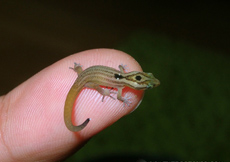Sphaerodactylus macrolepis
(GÜNTHER, 1859)
Distribution:
Sphaerodactylus macrolepis has 10 subspecies found on the Caribbean island of Puerto Rico, as well as the upstream smaller islands. The north of Puerto Rico is home to the subspecies Sphaerodactylus macrolepis guarionex. The Northeast is being replaced by Sphaerodactylus macrolepis grandisquamis, which formerly, completely inhabited the entire east of Puerto Rico. The central south and south-east of the island is home to Sphaerodactylus macrolepis mimetes. Adjacent to the west of this, is the area of distribution of the subspecies Sphaerodactylus macrolepis ateles, which is located in the south-west, with the exception of the dry coastal regions. In the central highlands of the island occurs Sphaerodactylus macrolepis spanius and an undescribed subspecies of the genus. Puerto Rico is also home to the Sphaerodactylus species S. roosevelti, S. klauberi, S. townsendi, S. nicholsi, S. parthenopion and S. gaigeae.
Description:
Depending on the subspecies, Sphaerodactylus macrolepis is a medium to large member of the genus Sphaerodactylus. The largest subspecies, is from the central highlands of Puerto Rico having a total length of 8 centimeters. Most subspecies remain significantly smaller, with a total length between 6.5-7 centimeters. Some, such as S. macrolepis mimetes, only reach a total length of 6 ccentimeters. Characteristic of the genus, Sphaerodactylus macrolepis has rough overlapping dorsal scales (like roof tiles). The basic coloration of the body varies, depending on the subspecies from light brown to gray, with the tail being a yellowish-orange color. The males of most subspecies also have a yellow-orange head. All males of S. macrolepis have a yellow throat, making them easy to distinguish from the females. The females usually have a light gray head coloration. In both sexes, dark brown to red dots may be observed from the head to the tail, depending on the subspecies, these may also merge in to stripes. Typically, the two white ocelli are on a black background in the neck, which however are lost on males at sexual maturity. The pupils of all subspecies characterizes them as diurnal.
Habitat:
Sphaerodactylus macrolepis are considered a generalist of the genus Sphaerodactylus. They are found in all types of habitats on Puerto Rico with the exception of dry forests. You can find S. macrolepis not only on the ground, under stones and larger dead plants, but also under the bark of trees up to 2 meters in height. The microhabitats are always slightly damp, regardless of the habitat.
Husbandry and Breeding:
While Sphaerodactylus macrolepis is one of the larger representatives of the genus Sphaerodactylus, it is quite possible due to their small final size to house a pair in a terrarium with an edge length of 20 centimeters. However, a larger terrarium offers more space for various design options and is better, as climatic conditions are far easier to maintain.
It is always advisable to use cork backgrounds on the rear and side walls, or individual flat cork pieces may used in addition to a filler. A staple in any Sphaerodactylus terrarium is the addition of flat pieces of cork and tubes, which should be placed against the walls, so that the animals can seek a hiding spot or location to lay their eggs. Smaller pieces of cork placed on the ground offer additional hiding locations. When planting the terrarium, small bromeliad species, as well as small leaved trailing plants, may be used. A natural planting of the terrarium helps provide a better microclimate and makes for a more visually appealing centerpiece. The substrate should be a mixture of soil and sand in a ratio of 2:1. A small water bowl and a bowl of eggshells or cuttlefish bone (crushed - not ground) are a must in completing the setup.
Illumination of the terrarium may be provided via T5 or T8 tubes. To help simulate a natural seasonal rhythm, the illumination period should be for 12 hours daily in the summer months and reduced to 9 hours in winter. An additional heat spot in the form of a halogen puck light or similiar, serves as a local heat source and is often visited by the geckos. To help maintain proper humidity, the terrarium should be misted once daily.
During the breeding season, females lay a single egg every 3-4 weeks. Tubes of dried Japanese knotweed (Reynoutria japonica), or bamboo are greatly sought after by the females to lay their eggs. These also facilitate the ease of removal of the eggs, in order to transfer them to an incubation location. Some subspecies however, bury their eggs or place them under bark on the ground. Depending on the incubation temperatures the young animals, which resemble the females in coloration emerge after a period of 60-100 days. The young may be raised with other members of the genus Sphaerodactylus or Gonatodes, in small converted household containers. At around 4 months of age, young males will begin to show their true coloration.
The terrarium of Sphaerodactylus macrolepis should be seeded with springtails and isopods (in an appropriate size for the gecko) for them to freely eat. For a change in diet, pea aphids, bean beetles, fruit flies, firebrats and small wax moths or their larvae should also be offered.
Sphaerodactylus macrolepis is an excellent terrarium inhabitant, as they are extremely tame after a certain period of acclimatization. It is quite common that the animals can be fed not only by tweezers, but also directly from your hand. Furthermore, it is a great advantage that the eggs do not have to absolutely be removed from the terrarium, as the adult do not attack or eat the young offspring. If the offspring share the terrarium with the adults, they should be pulled from the terrarium before they reach sexual maturity.
Currently, Sphaerodactylus macrolepis is being revised scientifically, as it has become apparent that individual subspecies are actually separate species.















